Partha Pratim Das
Towards an Action-Centric Ontology for Cooking Procedures Using Temporal Graphs
Sep 04, 2025Abstract:Formalizing cooking procedures remains a challenging task due to their inherent complexity and ambiguity. We introduce an extensible domain-specific language for representing recipes as directed action graphs, capturing processes, transfers, environments, concurrency, and compositional structure. Our approach enables precise, modular modeling of complex culinary workflows. Initial manual evaluation on a full English breakfast recipe demonstrates the DSL's expressiveness and suitability for future automated recipe analysis and execution. This work represents initial steps towards an action-centric ontology for cooking, using temporal graphs to enable structured machine understanding, precise interpretation, and scalable automation of culinary processes - both in home kitchens and professional culinary settings.
Unsupervised Multi-Clustering and Decision-Making Strategies for 4D-STEM Orientation Mapping
Mar 09, 2025Abstract:This study presents a novel integration of unsupervised learning and decision-making strategies for the advanced analysis of 4D-STEM datasets, with a focus on non-negative matrix factorization (NMF) as the primary clustering method. Our approach introduces a systematic framework to determine the optimal number of components (k) required for robust and interpretable orientation mapping. By leveraging the K-Component Loss method and Image Quality Assessment (IQA) metrics, we effectively balance reconstruction fidelity and model complexity. Additionally, we highlight the critical role of dataset preprocessing in improving clustering stability and accuracy. Furthermore, our spatial weight matrix analysis provides insights into overlapping regions within the dataset by employing threshold-based visualization, facilitating a detailed understanding of cluster interactions. The results demonstrate the potential of combining NMF with advanced IQA metrics and preprocessing techniques for reliable orientation mapping and structural analysis in 4D-STEM datasets, paving the way for future applications in multi-dimensional material characterization.
Enhancing FKG.in: automating Indian food composition analysis
Dec 09, 2024


Abstract:This paper presents a novel approach to compute food composition data for Indian recipes using a knowledge graph for Indian food (FKG.in) and LLMs. The primary focus is to provide a broad overview of an automated food composition analysis workflow and describe its core functionalities: nutrition data aggregation, food composition analysis, and LLM-augmented information resolution. This workflow aims to complement FKG.in and iteratively supplement food composition data from verified knowledge bases. Additionally, this paper highlights the challenges of representing Indian food and accessing food composition data digitally. It also reviews three key sources of food composition data: the Indian Food Composition Tables, the Indian Nutrient Databank, and the Nutritionix API. Furthermore, it briefly outlines how users can interact with the workflow to obtain diet-based health recommendations and detailed food composition information for numerous recipes. We then explore the complex challenges of analyzing Indian recipe information across dimensions such as structure, multilingualism, and uncertainty as well as present our ongoing work on LLM-based solutions to address these issues. The methods proposed in this workshop paper for AI-driven knowledge curation and information resolution are application-agnostic, generalizable, and replicable for any domain.
Building FKG.in: a Knowledge Graph for Indian Food
Sep 01, 2024


Abstract:This paper presents an ontology design along with knowledge engineering, and multilingual semantic reasoning techniques to build an automated system for assimilating culinary information for Indian food in the form of a knowledge graph. The main focus is on designing intelligent methods to derive ontology designs and capture all-encompassing knowledge about food, recipes, ingredients, cooking characteristics, and most importantly, nutrition, at scale. We present our ongoing work in this workshop paper, describe in some detail the relevant challenges in curating knowledge of Indian food, and propose our high-level ontology design. We also present a novel workflow that uses AI, LLM, and language technology to curate information from recipe blog sites in the public domain to build knowledge graphs for Indian food. The methods for knowledge curation proposed in this paper are generic and can be replicated for any domain. The design is application-agnostic and can be used for AI-driven smart analysis, building recommendation systems for Personalized Digital Health, and complementing the knowledge graph for Indian food with contextual information such as user information, food biochemistry, geographic information, agricultural information, etc.
Generative AI for Software Metadata: Overview of the Information Retrieval in Software Engineering Track at FIRE 2023
Oct 27, 2023Abstract:The Information Retrieval in Software Engineering (IRSE) track aims to develop solutions for automated evaluation of code comments in a machine learning framework based on human and large language model generated labels. In this track, there is a binary classification task to classify comments as useful and not useful. The dataset consists of 9048 code comments and surrounding code snippet pairs extracted from open source github C based projects and an additional dataset generated individually by teams using large language models. Overall 56 experiments have been submitted by 17 teams from various universities and software companies. The submissions have been evaluated quantitatively using the F1-Score and qualitatively based on the type of features developed, the supervised learning model used and their corresponding hyper-parameters. The labels generated from large language models increase the bias in the prediction model but lead to less over-fitted results.
Smart Knowledge Transfer using Google-like Search
Aug 12, 2023Abstract:To address the issue of rising software maintenance cost due to program comprehension challenges, we propose SMARTKT (Smart Knowledge Transfer), a search framework, which extracts and integrates knowledge related to various aspects of an application in form of a semantic graph. This graph supports syntax and semantic queries and converts the process of program comprehension into a {\em google-like} search problem.
Improving Contextualized Topic Models with Negative Sampling
Mar 27, 2023



Abstract:Topic modeling has emerged as a dominant method for exploring large document collections. Recent approaches to topic modeling use large contextualized language models and variational autoencoders. In this paper, we propose a negative sampling mechanism for a contextualized topic model to improve the quality of the generated topics. In particular, during model training, we perturb the generated document-topic vector and use a triplet loss to encourage the document reconstructed from the correct document-topic vector to be similar to the input document and dissimilar to the document reconstructed from the perturbed vector. Experiments for different topic counts on three publicly available benchmark datasets show that in most cases, our approach leads to an increase in topic coherence over that of the baselines. Our model also achieves very high topic diversity.
Generation of Highlights from Research Papers Using Pointer-Generator Networks and SciBERT Embeddings
Feb 14, 2023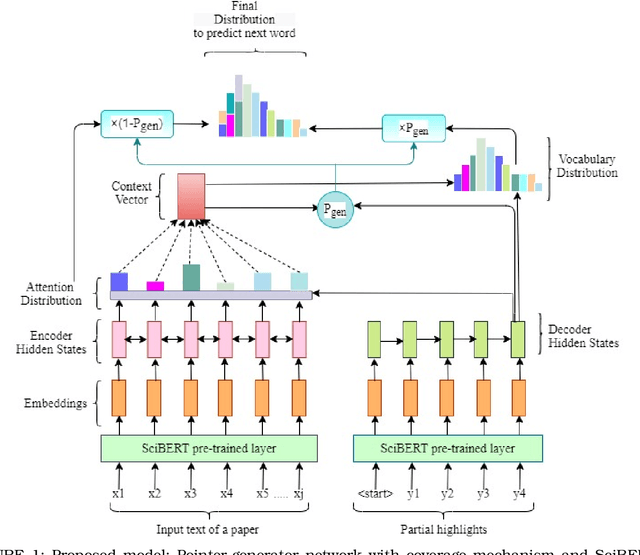
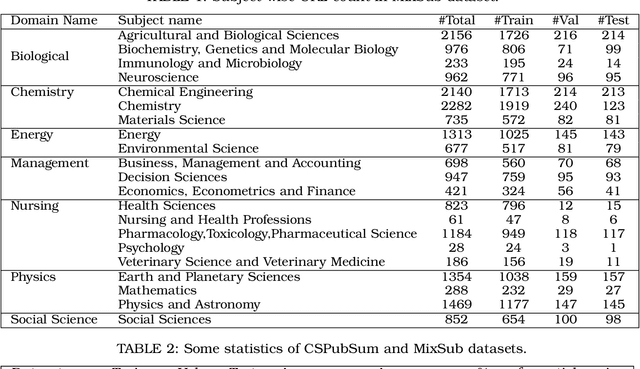
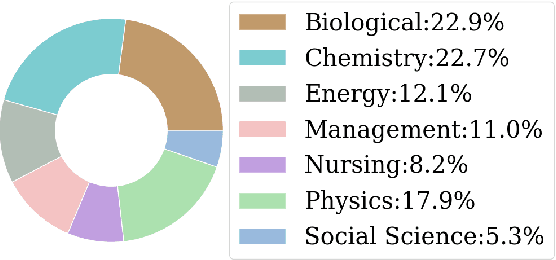

Abstract:Nowadays many research articles are prefaced with research highlights to summarize the main findings of the paper. Highlights not only help researchers precisely and quickly identify the contributions of a paper, they also enhance the discoverability of the article via search engines. We aim to automatically construct research highlights given certain segments of the research paper. We use a pointer-generator network with coverage mechanism and a contextual embedding layer at the input that encodes the input tokens into SciBERT embeddings. We test our model on a benchmark dataset, CSPubSum and also present MixSub, a new multi-disciplinary corpus of papers for automatic research highlight generation. For both CSPubSum and MixSub, we have observed that the proposed model achieves the best performance compared to related variants and other models proposed in the literature. On the CSPubSum data set, our model achieves the best performance when the input is only the abstract of a paper as opposed to other segments of the paper. It produces ROUGE-1, ROUGE-2 and ROUGE-L F1-scores of 38.26, 14.26 and 35.51, respectively, METEOR F1-score of 32.62, and BERTScore F1 of 86.65 which outperform all other baselines. On the new MixSub data set, where only the abstract is the input, our proposed model (when trained on the whole training corpus without distinguishing between the subject categories) achieves ROUGE-1, ROUGE-2 and ROUGE-L F1-scores of 31.78, 9.76 and 29.3, respectively, METEOR F1-score of 24.00, and BERTScore F1 of 85.25, outperforming other models.
Melody Extraction from Polyphonic Music by Deep Learning Approaches: A Review
Feb 02, 2022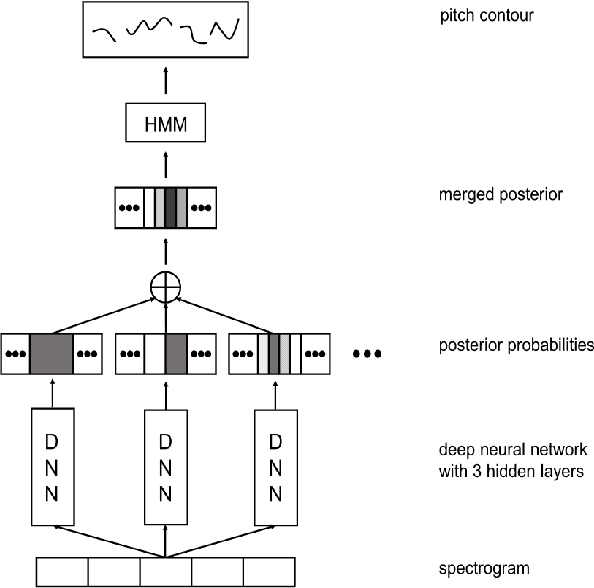
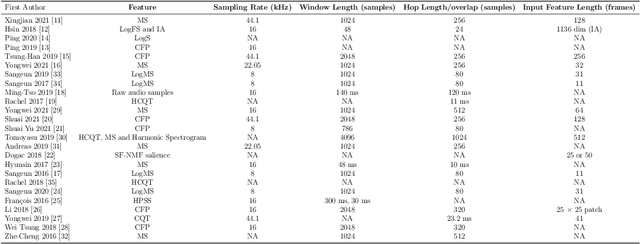
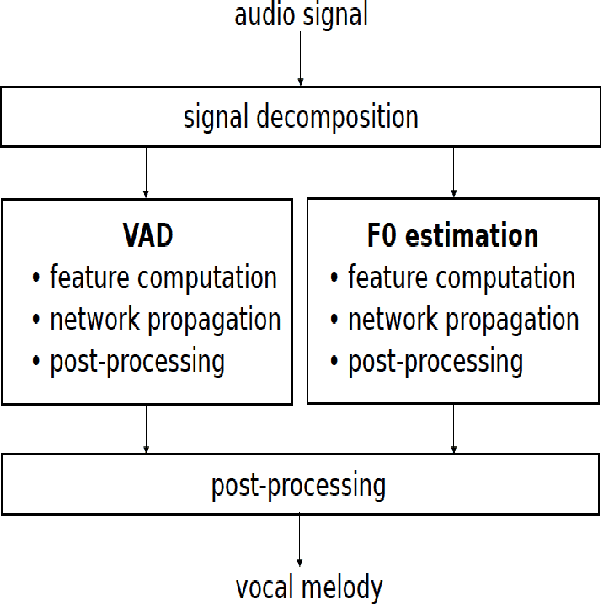

Abstract:Melody extraction is a vital music information retrieval task among music researchers for its potential applications in education pedagogy and the music industry. Melody extraction is a notoriously challenging task due to the presence of background instruments. Also, often melodic source exhibits similar characteristics to that of the other instruments. The interfering background accompaniment with the vocals makes extracting the melody from the mixture signal much more challenging. Until recently, classical signal processing-based melody extraction methods were quite popular among melody extraction researchers. The ability of the deep learning models to model large-scale data and the ability of the models to learn automatic features by exploiting spatial and temporal dependencies inspired many researchers to adopt deep learning models for melody extraction. In this paper, an attempt has been made to review the up-to-date data-driven deep learning approaches for melody extraction from polyphonic music. The available deep models have been categorized based on the type of neural network used and the output representation they use for predicting melody. Further, the architectures of the 25 melody extraction models are briefly presented. The loss functions used to optimize the model parameters of the melody extraction models are broadly categorized into four categories and briefly describe the loss functions used by various melody extraction models. Also, the various input representations adopted by the melody extraction models and the parameter settings are deeply described. A section describing the explainability of the block-box melody extraction deep neural networks is included. The performance of 25 melody extraction methods is compared. The possible future directions to explore/improve the melody extraction methods are also presented in the paper.
Incorporating Domain Knowledge To Improve Topic Segmentation Of Long MOOC Lecture Videos
Dec 08, 2020



Abstract:Topical Segmentation poses a great role in reducing search space of the topics taught in a lecture video specially when the video metadata lacks topic wise segmentation information. This segmentation information eases user efforts of searching, locating and browsing a topic inside a lecture video. In this work we propose an algorithm, that combines state-of-the art language model and domain knowledge graph for automatically detecting different coherent topics present inside a long lecture video. We use the language model on speech-to-text transcription to capture the implicit meaning of the whole video while the knowledge graph provides us the domain specific dependencies between different concepts of that subjects. Also leveraging the domain knowledge we can capture the way instructor binds and connects different concepts while teaching, which helps us in achieving better segmentation accuracy. We tested our approach on NPTEL lecture videos and holistic evaluation shows that it out performs the other methods described in the literature.
 Add to Chrome
Add to Chrome Add to Firefox
Add to Firefox Add to Edge
Add to Edge